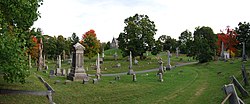Oakwood Cemetery | |
 Section G-4 of Oakwood Cemetery, overlooking Sections G-3 and H-1 | |
| Location | 50 101st Street, Troy, New York, United States |
|---|---|
| Coordinates | 42°45′50″N 73°39′59″W / 42.76389°N 73.66639°W |
| Area | Total: 352 acres (142 ha) NRHP Property: 325 acres (132 ha) |
| Built | 1848 |
| Architect | John C. Sidney John Boetcher |
| Architectural style | Greek Revival, Roman Revival, Gothic Revival, Romanesque, Egyptian Revival, Palladian, and other eclectic styles |
| NRHP reference No. | 84000021[1] |
| Added to NRHP | 1984 |
Oakwood Cemetery is a nonsectarian rural cemetery in northeastern Troy, New York, United States. It operates under the direction of the Troy Cemetery Association, a non-profit board of directors that deals strictly with the operation of the cemetery.[2] It was established in 1848 in response to the growing rural cemetery movement in New England and went into service in 1850. The cemetery was designed by architect John C. Sidney and underwent its greatest development in the late 19th century under superintendent John Boetcher, who incorporated rare foliage and a clear landscape design strategy. Oakwood was the fourth rural cemetery opened in New York and its governing body was the first rural cemetery association created in the state.
It features four man-made lakes, two residential structures, a chapel, a crematorium, 24 mausolea, and about 60,000 graves, and has about 29 miles (47 km) of roads. It is known both for its dense foliage and rolling lawns, and has historically been used as a public park by Lansingburgh[Note 1] and Troy residents. Oakwood was added to the National Register of Historic Places in 1984.
Prominent Americans such as Uncle Sam Wilson, Russell Sage, and Emma Willard, at least fourteen members of the United States House of Representatives, and the founders of both Troy and Lansingburgh are buried at Oakwood. The cemetery has been said to be "one of New York State's most distinguished and well-preserved nineteenth-century rural cemeteries."[4] It also offers a famous panoramic view of the Hudson River Valley that is said to be the "most concentrated and complete overview of American history anywhere in America".[5]
- ^ "National Register Information System". National Register of Historic Places. National Park Service. April 15, 2008.
- ^ Cite error: The named reference
aboutwas invoked but never defined (see the help page). - ^ Charter of and laws relating to the city of Troy, p. 216
- ^ Cite error: The named reference
nrhp9was invoked but never defined (see the help page). - ^ Cite error: The named reference
historywas invoked but never defined (see the help page).
Cite error: There are <ref group=Note> tags on this page, but the references will not show without a {{reflist|group=Note}} template (see the help page).
© MMXXIII Rich X Search. We shall prevail. All rights reserved. Rich X Search


